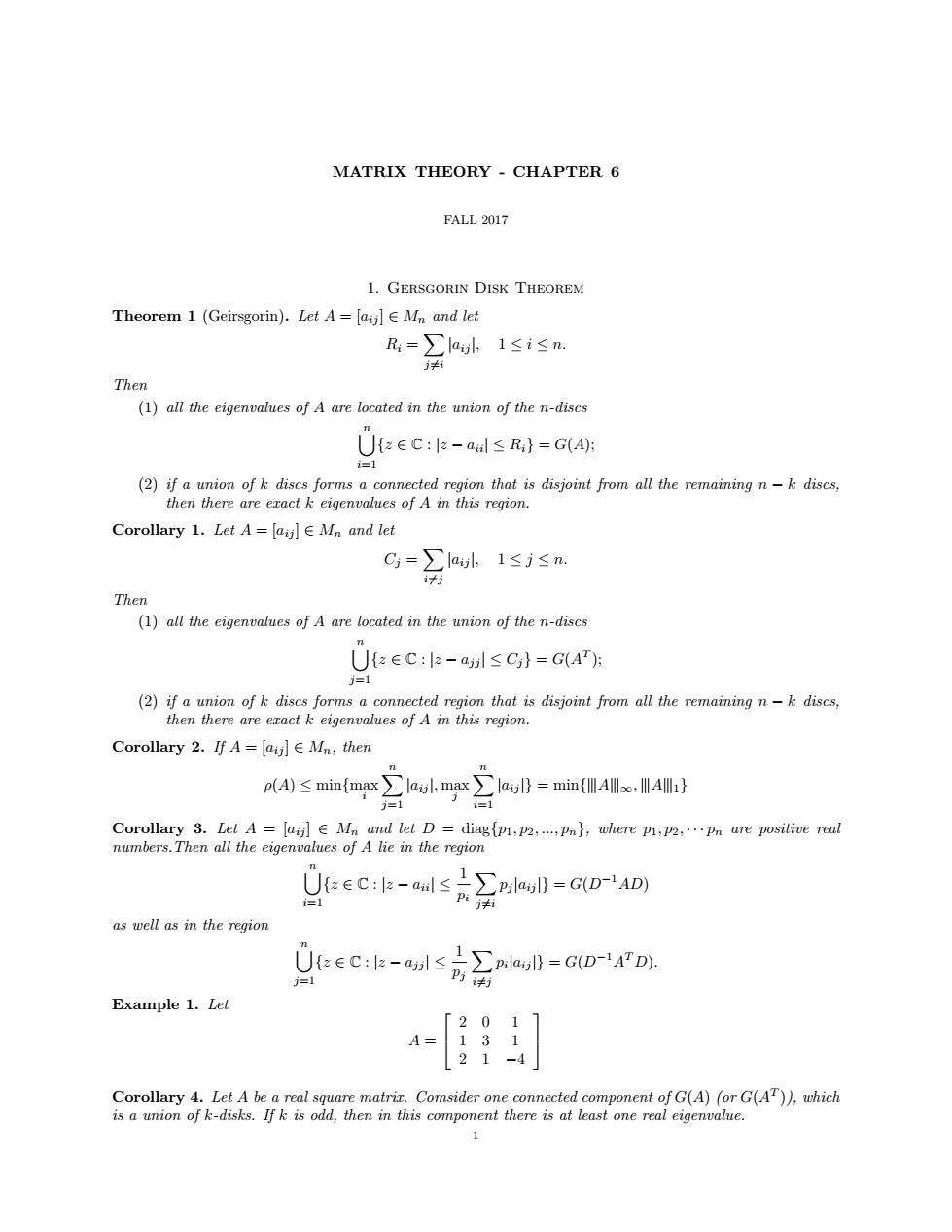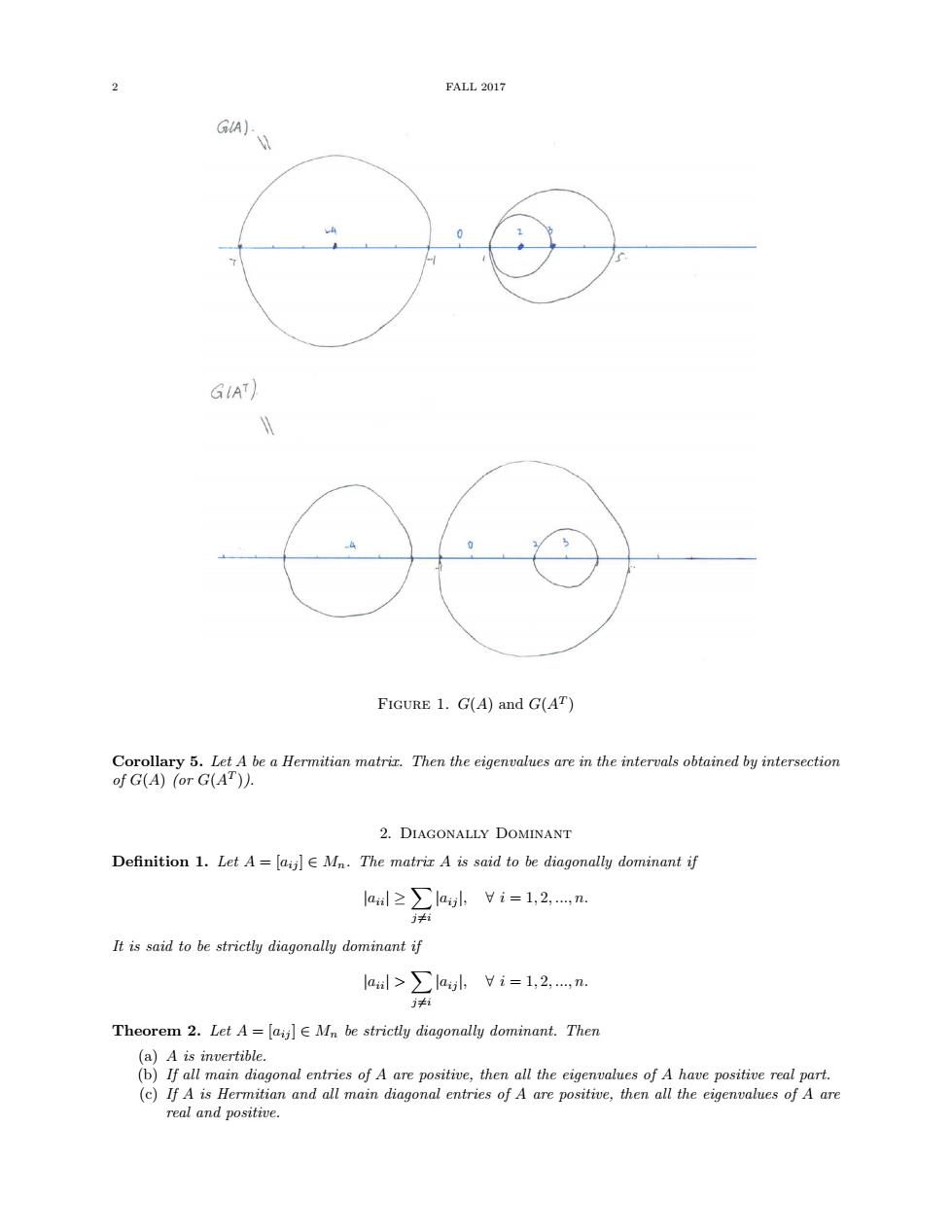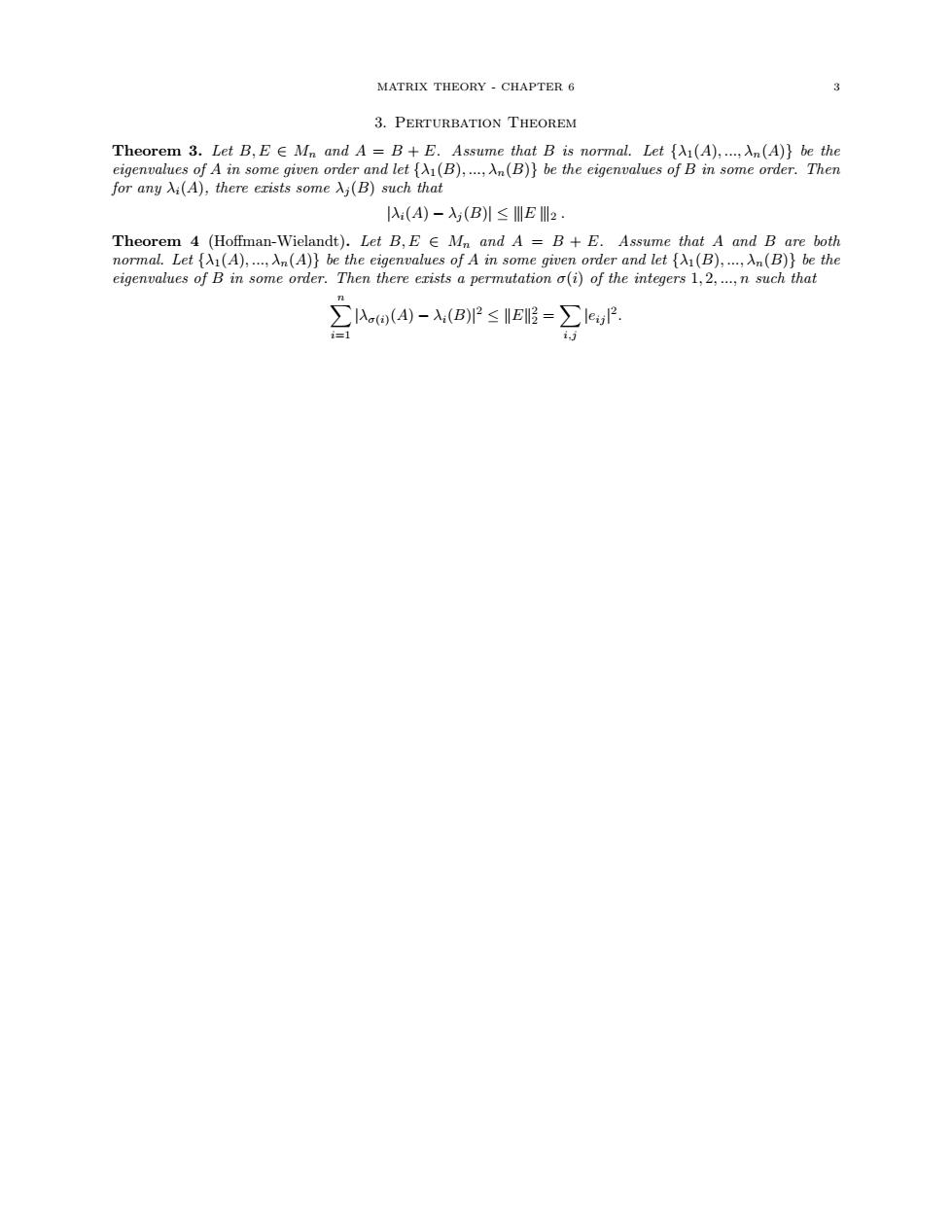
MATRIX THEORY CHAPTER 6 FALL 2017 1.GERSGORIN DISK THEOREM Theorem 1 (Geirsgorin).Let A=[alE Mn and let R,=∑lal,1≤i≤n. ji Then (1)all the eigenvalues of A are located in the union of the n-discs UzeC:-al≤R}=G(A) (2)if a union of k dises forms a comnected region that is disjoint from all the remaining n-k discs. then there are eract k eigenvalues of A in this region. Corollary 1.Let A=M and let C=∑lal1≤j≤n 南 Then (1)all the eigenvalues of A are located in the union of the n-discs U[zeC:2-al≤C}=G(AT方 j=1 (2)if a union of k discs forms a connected region that is disjoint from all the remaining n-k discs, then there are eract k eigenvalues of A in this region. Corollary 2.If A=[]Mn,then p(4≤min{max∑lal.max∑al}=min{lAle,lA} 1■1 Corollary 3.Let A=a]Mn and let D=diag(pi,pa.....),where p,pa.pn are positive real numbers.Then all the eigenvalues of A lie in the region tec:-s-(o-tAD) as well as in the region U(EC:k-apls>plaull -G(D-ATD). 卫街 Example 1.Let 21-4
MATRIX THEORY - CHAPTER 6 FALL 2017 1. Gersgorin Disk Theorem Theorem 1 (Geirsgorin). Let A = [aij ] ∈ Mn and let Ri = X j6=i |aij |, 1 ≤ i ≤ n. Then (1) all the eigenvalues of A are located in the union of the n-discs [n i=1 {z ∈ C : |z − aii| ≤ Ri} = G(A); (2) if a union of k discs forms a connected region that is disjoint from all the remaining n − k discs, then there are exact k eigenvalues of A in this region. Corollary 1. Let A = [aij ] ∈ Mn and let Cj = X i6=j |aij |, 1 ≤ j ≤ n. Then (1) all the eigenvalues of A are located in the union of the n-discs [n j=1 {z ∈ C : |z − ajj | ≤ Cj} = G(A T ); (2) if a union of k discs forms a connected region that is disjoint from all the remaining n − k discs, then there are exact k eigenvalues of A in this region. Corollary 2. If A = [aij ] ∈ Mn, then ρ(A) ≤ min{max i Xn j=1 |aij |, max j Xn i=1 |aij |} = min{9A9∞,9A91} Corollary 3. Let A = [aij ] ∈ Mn and let D = diag{p1, p2, ..., pn}, where p1, p2, · · · pn are positive real numbers.Then all the eigenvalues of A lie in the region [n i=1 {z ∈ C : |z − aii| ≤ 1 pi X j6=i pj |aij |} = G(D−1AD) as well as in the region [n j=1 {z ∈ C : |z − ajj | ≤ 1 pj X i6=j pi |aij |} = G(D−1A T D). Example 1. Let A = 2 0 1 1 3 1 2 1 −4 Corollary 4. Let A be a real square matrix. Comsider one connected component of G(A) (or G(AT )), which is a union of k-disks. If k is odd, then in this component there is at least one real eigenvalue. 1

2 FALL 2017 GA) GIAT) FIGURE 1.G(A)and G(AT) Corollary 5.Let A be a Hermitian matrir.Then the eigenvalues are in the intervals obtained by intersection 时G(4)(or G(AT) 2.DIAGONALLY DOMINANT Definition 1.Let A=Mn.The matrir A is said to be diagonally dominantif al≥∑ali=1,2…,n It is said to be strictly diagonally dominant if laidl laigl,vi=1.2.....n. Theorem 2.Let A=aMn be strictly diagonally dominant.Then (a)A is invertible. (b)If all main dingonal entries of A are positive,then all the cigenvalues of A have positive real part. (c)If A is Hermitian and all main diagonal entries of A are positive,then all the eigenvalues of A are
2 FALL 2017 Figure 1. G(A) and G(AT ) Corollary 5. Let A be a Hermitian matrix. Then the eigenvalues are in the intervals obtained by intersection of G(A) (or G(AT )). 2. Diagonally Dominant Definition 1. Let A = [aij ] ∈ Mn. The matrix A is said to be diagonally dominant if |aii| ≥ X j6=i |aij |, ∀ i = 1, 2, ..., n. It is said to be strictly diagonally dominant if |aii| > X j6=i |aij |, ∀ i = 1, 2, ..., n. Theorem 2. Let A = [aij ] ∈ Mn be strictly diagonally dominant. Then (a) A is invertible. (b) If all main diagonal entries of A are positive, then all the eigenvalues of A have positive real part. (c) If A is Hermitian and all main diagonal entries of A are positive, then all the eigenvalues of A are real and positive

MATRIX THEORY CHAPTER 6 3.PERTURBATION THEOREM Theorem 3.Let B,E Mn and A=B+E.Assume that B is normal.Let ((A)....n(A)}be the eigenvalues of A in some given order and let ((B),(B)}be the eigenvalues of B in some order.Then for any i(A),there erists some j(B)such that A(A)-入y(B引≤IEIl2 Theorem 4 (Hoffman-Wielandt).Let B,EE Mn and A=B+E.Assume that A and B are both eso时A in some give Then ∑Ao(4-A(BP≤E3=∑leP
MATRIX THEORY - CHAPTER 6 3 3. Perturbation Theorem Theorem 3. Let B, E ∈ Mn and A = B + E. Assume that B is normal. Let {λ1(A), ..., λn(A)} be the eigenvalues of A in some given order and let {λ1(B), ..., λn(B)} be the eigenvalues of B in some order. Then for any λi(A), there exists some λj (B) such that |λi(A) − λj (B)| ≤ 9E 92 . Theorem 4 (Hoffman-Wielandt). Let B, E ∈ Mn and A = B + E. Assume that A and B are both normal. Let {λ1(A), ..., λn(A)} be the eigenvalues of A in some given order and let {λ1(B), ..., λn(B)} be the eigenvalues of B in some order. Then there exists a permutation σ(i) of the integers 1, 2, ..., n such that Xn i=1 |λσ(i)(A) − λi(B)| 2 ≤ kEk 2 2 = X i,j |eij | 2